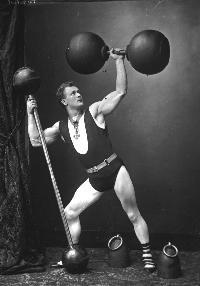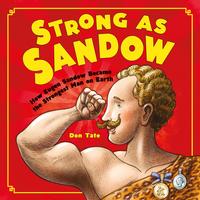Author, illustrator, and Ezra Jack Keats Award winner Don Tate recently visited the Children's Literature Research Collection to research an upcoming title. During his visit, Don sat down with us to answer a few questions about his career and his writing process. Don also spoke to an illustrator's critique group for the Society of Children's Book Writers and Illustrators (SCBWI) and gave the group sage advice on the world of publishing.
You recently released Strong as Sandow, a picture book biography of one of the first internationally famous bodybuilders. Tell me about the inspiration for this title.
Many years ago, my younger brother competed and won a statewide bodybuilding competition. I attended that show and was inspired to give bodybuilding a try myself. I’d always been a super skinny kid, so the idea of working out and looking like a superhero on stage excited me.
A year after my brother’s show, I competed and completely lost. I was embarrassed, but I didn’t give up. The following year, I competed again and won a first- and second-place trophy in my divisions. It was one of the best experiences of my life. I met so many people that night who had overcome health obstacles to get into the best physical shape of their lives.
Over the years, I thought about writing about bodybuilding . . . or a bodybuilder, or something related, though I couldn’t think of an angle. When I discovered pictures online of Eugen Sandow lifting heavy barbells over his head and learned about how he was once a skinny kid who desired to get healthier, I knew it was the perfect subject for me to write about.
Your passion for fitness is evident in Strong as Sandow. It's a great biography, and it’s a topic that isn't often explored for children. There are a lot of biographies on women gymnasts, but very little for children interested in body building. The backmatter and additional research information in the book is very impressive. When you’re researching a topic, do you have a methodology that you follow?
I like to begin by drawing a timeline. As I research, I plot information along that timeline, so that I can see the person’s life laid out on paper. Then I ask myself, trying to determine, based on what I’ve learned: What was the person’s biggest life goal or motivation to reaching their goal. In Sandow’s case, he wanted to get stronger and healthier. To humanize a character, readers also need to see how a character fails in trying to reach that goal, before finally succeeding. That becomes the story that I write.
I’ll write the first draft. And then a second draft. And a twenty-ninth and fortieth draft. All of that happens before an editor ever sees a story. And then the revision process starts again.
As a public library that supports casual and academic researchers, we can't tell you how much we love that answer! That's a great way to understand the life of an individual. Do you have a favorite part of the research process?
I think my favorite part is the revision process. Working with my editor, the back and forth of making my story stronger. Sometimes it can be frustrating to get a long letter with revision requests. However, I also know that the result will be a better story.
I also love the visual research process, too. For Sandow, I studied images of Victorian strongmen, old-time circuses, German acrobats of the 19th century. Interesting photos. And a lot of handlebar mustaches!
The revision process can be tough, but it’s always worth it. What types of books did you read as a child?
Embarrassing to say, but I wasn’t much of a reader as a kid. I’d rather spend my time drawing and making stuff. But when I did read, I loved our Better Homes & Gardens Illustrated Medical Encyclopedia. I also loved our Funk & Wagnalls Young Student’s Encyclopedias, too. They featured stories, drawings, and photographs of all kinds of people from all over the world.
I also loved “believe it or not” sideshow type of stories, like the tallest man in the world who married the tiny woman. Or the hairy-faced girl, or the Elephant Man. I really loved those kinds of stories. One summer in middle school, I got a summer job. One of my jobs was to wash shelves in the library. So I spent many afternoons reading about all sorts of interesting people.
Spoken like a true writer of nonfiction. Those types of books are available at the Free Library , and are still wildly popular. As part of your visit, you spoke with one of our local SCBWI illustrators' critique groups. For the future authors and illustrators who are reading this online, what advice would you give in regards to getting published?
Try not to think about the publishing part. Instead, focus on polishing your writing and/or illustrating skills. And study the industry. Almost daily now, I get emails from aspiring writers asking me if I'd be interested in illustrating their manuscripts. And that tells me right away that they haven't bothered to study the industry they want to be a part of. You can't become a lawyer without studying law. You can't become a surgeon without studying medicine. So why do folks think they can become a published author or illustrator without studying the book industry?
That's great advice Don. Thank you for telling us about your writing process!
Individuals or classes with an interest in the history, study, and/or development of children's literature will find the Children's Literature Research Collection (CLRC) an invaluable resource. CLRC houses over 85,000 non-circulating items from the 1830s through the present.
Have a question for Free Library staff? Please submit it to our Ask a Librarian page and receive a response within two business days.



